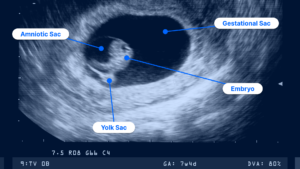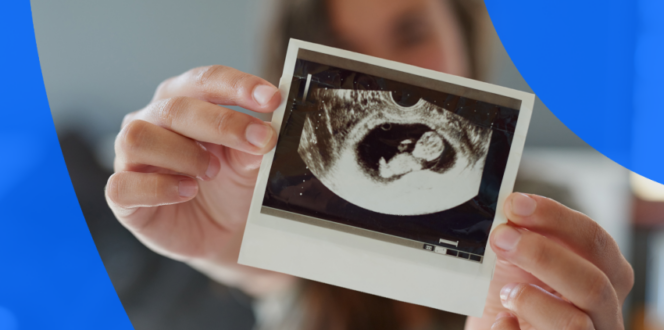Pregnancy Ultrasound 101: Everything You Need to Know

Getting a pregnancy ultrasound can be exciting, but it can also be nerve-wracking. Here’s what to know before your next appointment.
When you’re expecting, ultrasounds are a big part of your pregnancy journey. Not only do pregnancy ultrasounds help you and your healthcare team learn about your baby’s health and development, but they’re an excellent way to share your experience with family and friends.
It’s normal to experience a range of emotions around ultrasound appointments. Whether you’re nervously awaiting results or excitedly anticipating your next scan, the more you know about prenatal ultrasounds and why they’re performed, the more prepared you’ll feel at your appointments. In this article, you’ll learn the ins and outs of your upcoming ultrasounds, including:
- How pregnancy ultrasounds work
- When to get a pregnancy ultrasound
- Tips to prepare for your appointment
- How to understand the results
What is a pregnancy ultrasound?
First things first! Ultrasounds use sound waves to capture live images of your baby—pictures you can see right away on the ultrasound monitor. A pregnancy ultrasound is sometimes called a sonogram.
Your practitioner will send you for an ultrasound at least twice during your pregnancy. They’ll want to confirm the pregnancy by observing a heartbeat, determine gestational age and sex of your baby, as well as monitor growth and development. If you have a complicated or high-risk pregnancy, you might be sent for ultrasounds more frequently. This lets your practitioner check for development issues or screen for complications. A pregnancy may be classified as high risk if there is any reason to believe the baby may not be carried to full term or if health concerns are likely to arise.
A pregnancy might be considered high risk if a woman:
- Is under 17 or over 35 years old
- Has high blood pressure
- Has diabetes
- Has a mental health condition
- Has had complications with an earlier pregnancy
- Is carrying twins or more than two fetuses
Are ultrasounds safe?
Yes, when performed by a trained sonographer, ultrasound technician, or radiologist according to Health Canada and the U.S. Food & Drug Administration. 2D, 3D, 4D and Doppler ultrasounds use the same sound-wave technology to safely capture images inside your body. Unlike X-rays, ultrasounds don’t use radiation to capture images. Only practitioners trained to perform fetal ultrasounds can give you a pregnancy ultrasound.
How does a pregnancy ultrasound work?
During an ultrasound, a physician, ultrasound technician, or trained sonographer uses a hand-held device called a transducer. The transducer creates sound waves (too quiet for human ears to hear) that travel painlessly through your body to your baby. An ultrasound machine then detects the sound waves and uses them to create an image of the exact position and shape of your baby. Ultrasounds typically produce a flat, 2D image of your baby, but 3D ultrasounds can give you a more detailed view.
3D and 4D ultrasounds can be very exciting for expectant parents because they can show facial expressions and allow you to see what your baby looks like. These types of ultrasounds can also be used in conjunction with 2D diagnostic ultrasounds to showcase certain facial abnormalities, like a cleft palate.
There are five types of pregnancy ultrasounds:
- Transabdominal: During a transabdominal ultrasound, a sonographer will move the transducer over your belly to capture images of your baby.
- Transvaginal: During a transvaginal ultrasound, a sonographer will place a wand-shaped transducer inside your vagina to capture more detailed images of different parts of your baby, as well as your womb and cervix.
- Doppler: This specialized ultrasound helps your practitioner monitor the blood vessels and blood flow inside your uterus, cervix and the baby’s umbilical cord.
- 3D: A 3D ultrasound is a collection of images captured from a 2D ultrasound into one three-dimensional image, that lets you see more angles of your baby and lets your practitioner better visualize your baby’s internal organs.
- 4D: A 4D ultrasound goes one step further and creates a video of the images to show the movement of the baby’s body parts.
Why get a pregnancy ultrasound?
A pregnancy ultrasound is the best way for your practitioner to monitor your health and the development of your baby. Some common reasons your practitioner may send you for an ultrasound include:
- Confirming pregnancy
- Examining your ovaries and uterus
- Measuring baby’s crown rump length (CRL) to check growth and determine gestational age/due date
- Checking baby’s heartbeat, movement and muscle tone
- Checking baby’s position before delivery
Practitioners also use ultrasounds to help screen for specific health conditions or in response to certain events, like vaginal bleeding. Your practitioner may send you for an ultrasound to check for:
- Congenital disabilities: Structural or functional abnormalities can occur when a baby is still developing. A nuchal translucency scan, amniocentesis, chorionic villus sampling (CVS) and non-invasive prenatal testing (NIPT) are additional tests your doctor can recommend if there is any concern for congenital disabilities.
- Ectopic pregnancy: A condition that occurs when the embryo develops outside the uterus, often in a fallopian tube, as opposed to developing inside the uterus. A pregnancy where the embryo develops inside the uterus is known as an intrauterine pregnancy and is considered a viable pregnancy.
- Molar pregnancy: A complication indicated by the development of unusual cells that do not develop into a fetus.
- Miscarriage: An unexpected loss of a fetus before 20 weeks. Symptoms may include cramping and vaginal bleeding.
How many times during pregnancy do you get an ultrasound?
Your practitioner may send you for an ultrasound at any time during your pregnancy. Pregnancy ultrasounds typically happen only during the first and second trimesters unless the pregnancy is considered high-risk or complications develop.
How soon can you have a pregnancy ultrasound?
Your healthcare practitioner will likely send you for your first pregnancy ultrasound no earlier than 6 weeks since a heartbeat can’t be easily detected before then.
An early pregnancy ultrasound can show your doctor how the embryo is developing and how your body is responding. By 5 weeks it’s possible to view the gestational and yolk sacs, and by 7 weeks, you’ll be able to see the embryo inside the amniotic sac.
The yolk sac nourishes your baby and can be an important indicator of fetal health early in pregnancy. However, it can only be seen in early pregnancy ultrasounds, since it gets absorbed into your body after the development of your placenta by the end of the first trimester.

Ultrasound image at 7 weeks pregnant
During what weeks of pregnancy are ultrasounds done?
If your pregnancy is low risk, your practitioner will likely send you for two ultrasounds: One during the first trimester and one during the second trimester. If your pregnancy is high-risk or complicated, your practitioner may send you for further ultrasounds. Here’s a general guide about what to expect.
- Weeks 6-14 (Early first trimester): Your practitioner will send you for a routine 2D ultrasound to confirm pregnancy, estimate weeks of gestation, calculate the due date and determine the number of fetuses. If you’re carrying multiples (i.e., more than one embryo), this ultrasound will determine whether they share a placenta and amniotic sac.
- Weeks 10-13 (Late first trimester): Your practitioner may send you for an optional nuchal translucency (NT) ultrasound. An NT scan can determine your baby’s risk for Down Syndrome and other congenital heart, abdomen or skeletal abnormalities.
- Weeks 18-22 (Second trimester): Your practitioner will send you for an anatomy scan to check your baby’s growth, determine the sex of the baby, and for scan for any congenital disabilities. Your practitioner may also suggest you get an optional 3D ultrasound to check more closely for physical abnormalities.
- Weeks 27-40 (Third trimester): Your practitioner may not send you for an ultrasound during these weeks except, unless there are concerns about:
- Your baby’s growth or position
- The location of the placenta
- The length of your cervix
Your practitioner may also recommend further ultrasounds if you carry your baby longer than 40 weeks or as part of diagnostic tests for specific pregnancy concerns, such as CVS and amniocentesis.
Your practitioner may also suggest you go for an elective 3D ultrasound to check on any physical abnormalities already detected in a routine 2D ultrasound.
How to prepare for a pregnancy ultrasound appointment
Pregnancy ultrasounds require some preparation, and you may feel more comfortable attending your appointment if you know in advance what type of ultrasound you’ll be having. Transvaginal ultrasounds are typically done early in pregnancy because the embryo is so small, and this ultrasound can capture a better image from the vaginal canal.
You can prepare for your pregnancy ultrasound by:
- Arriving with a full bladder. Sound waves travel more easily through liquid, so a full bladder helps your sonographer capture the best image possible of your baby.
- Booking your appointment when your baby is more active. This allows the ultrasound to capture as many angles of your baby as possible. Drinking a cold sugary beverage right before your appointment can also help make your baby more active.
- Bringing someone who can support you during the appointment. Be sure to check ahead with the imaging clinic or hospital for guidance because not all facilities allow support persons to attend.
- Drinking lots of water in the week leading up to your ultrasound. Staying well hydrated helps keep amniotic fluid clear, allowing for better images.
- Wearing loose and comfortable clothing. Make sure that whatever you wear is easy to take off and put on, and that you don’t mind if it gets stained from the ultrasound gel.
If you’re worried about your ultrasound appointment, asking your practitioner or sonographer questions in advance can help you feel more prepared. Write down your questions ahead of time, including:
- Can I take my own photos and videos during the appointment?
- How do you share my images/results?
- How long is the appointment?
- How many people can join me?
Every ultrasound you attend gives your practitioner important information about your pregnancy, so remember to ask questions at your follow-up appointment, too.
Questions to ask during your ultrasound follow-up appointment
You can discuss your ultrasounds with your practitioner, but your sonographer cannot answer questions during your ultrasound. You may want to ask your practitioner these important questions at your follow-up appointment:
- Questions to ask about your first-trimester ultrasound(s): You can ask your practitioner about fetal heart rate, estimated date of conception, due date, and general health of the baby and placenta. If you’ve had an additional NT scan, you could ask about any risk factors detected.
- Questions to ask about your second-trimester ultrasound(s): You can ask your practitioner about the approximate size and weight of your growing baby or about any new physical differences that may have been detected during the scan. If you’d like to know the sex of your baby, you can ask at this time!
- Questions to ask about your third-trimester ultrasound(s): You can ask your practitioner about the size and weight of your baby and the position your baby is in. Ultrasounds done toward the end of the third trimester can indicate if your baby is moving into a safe delivery position.
How quickly can you get your ultrasound images and report?
We’ve heard that many patients want to see their ultrasound images and reports as quickly as possible. With PocketHealth, you can quickly and easily access and share your pregnancy ultrasound images and review your reports—often before seeing your practitioner for a follow-up. Access your records here.
The PocketHealth platform enables you to securely access, share and store your imaging and other health information all in one place. It also enables you to share images with family and friends, so they can see firsthand how your baby develops and changes throughout your pregnancy journey.
Because pregnancy ultrasound terminology can be confusing, PocketHealth’s Report Reader is there to help. Report Reader makes it easier to understand terms in your ultrasound report and feel more prepared when speaking to your pregnancy care practitioner.
Take control of your pregnancy journey
Pregnancy ultrasounds are a valuable medical tool that gives your practitioner important information about the growth of your baby, so understanding your pregnancy ultrasounds can reduce any stress around the unknowns that come with preparing for these appointments.
It’s also important to be informed when reviewing your results and speaking to your practitioner. Knowing which questions to ask helps you become a more active participant in your pregnancy care, no matter what trimester you’re in. Understanding why your practitioner has requested a pregnancy ultrasound can help you happily anticipate your next appointment and give you peace of mind throughout every step of your pregnancy.
How PocketHealth works
Learn more about how to use PocketHealth to access and share your pregnancy ultrasound records.
Published: June 29, 2023
Trusted by more than 800+ hospitals and clinics.



















